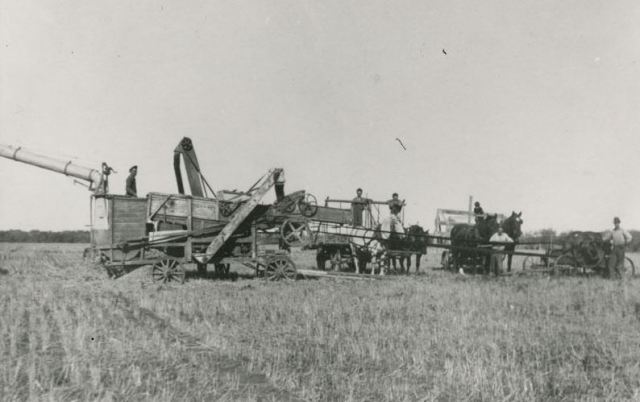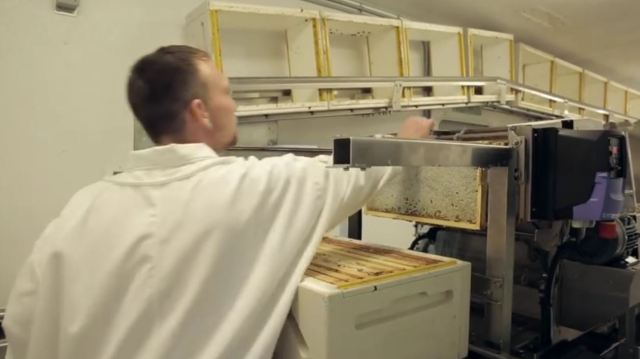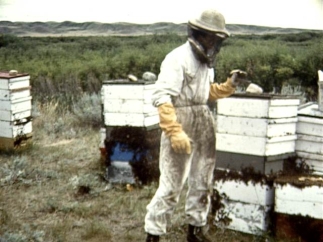
1930s Spirit River (Alberta, Canada) threshing crew.
Yup, we were still using draft horses here in the 1930s.
A century ago, threshing crews worked their away across the American and Canadian prairies, harvesting farmers’ grains. When I was rather young (not quite a century ago) one of my Saskatchewan buddies signed up for a threshing crew job. Maurice caught a bus to Texas where the wheat harvest began that year. He was one of fifteen young men who drove trucks and piloted swathers and combines for a custom harvesting company.
Like hungry locusts, the threshing crew would descend upon wheat fields and strip off thousands of acres of grain in a week. The farmers, of course, paid and fed the crew of custom combiners, but the farmer didn’t need to own big trucks or horrendously expensive harvesting equipment. Not every farmer used custom harvesting and today nearly all farmers own their own specialized machines. These are kept in sheds 46 weeks a year, then used by the farmer himself to gather the crop. I suppose – since the marketplace rules – it’s cheaper to own the equipment and do it one’s self than to hire custom harvesters. But in the days when bank credit was scarce and small farmers were struggling, hiring someone else to harvest was the only option for many.
There are a few reasons custom honey extracting was never a really big thing. Generally, the closest we’ve seen has been the sharing of an extractor, usually kept by one hobby beekeeper in his shed. Other hobby beekeepers would show up with a few supers and some pizza and extract at the friend’s shop. Typical pay for the guy who owned the extractor would be all the wax, maybe some honey, and all the pizza he could eat.
I used a similar system in Florida, forty years ago. It was on a larger scale, but the fellow doing the extracting was still paid in honey and pizza. Here was my situation: For about ten years, I produced a few thousand queen bees each winter. One year I unexpectedly also had a mess of honey. I took a couple truck loads of supers to a commercial beekeeper who extracted about 20 drums (12,000 pounds) for me. I drove almost two hours to get to his shop on Little Church Road and unloaded my boxes. He worked through the night processing my honey. I returned the next day to get my empty equipment, then a couple days later, I went back for my drums of honey, except for one that he kept as his fee. It was a lot of driving and it was modestly expensive. But I didn’t normally produce honey and didn’t own an extractor. The custom honey harvester had a neat, clean, and government-approved shop; I didn’t. And it had been an odd year with a nice surplus of orange blossom honey. Most years my mating nucs and cell builders were not so honey-bound. But that year, I had to handle some honey.
But, as I mentioned a moment ago, custom honey extracting never really caught on. There are reasons. First, the practice can spread American foulbrood. If infected equipment is extracted the day before processing your boxes, there is a chance of spreading disease to your equipment. The chance may be small, but foulbrood spores don’t always completely wash away with hot water. Even careful use of an extractor can spread disease.
The second reason custom extracting was never a big deals with timing. If my bees jam their supers, I need them off, extracted immediately, and returned to the hives as fast as possible. I’d be in trouble if the custom extracting shop is busy (because everyone else is also having a bumper crop and need boxes emptied quickly).
Cost, of course, is a consideration. Just as grain farmers have largely given up paying others to harvest for them, beekeepers would also be price wary. However, as honey house inspection requirements become more stringent and extracting equipment becomes more expensive, perhaps letting someone else handle extracting will become more cost effective. I was never happy looking at my expensive processing equipment in the off-season. From September to June, my uncapper, extractors, pump, and settling tanks just sat there, wondering if I had forgotten why I’d bought them.
A final reason that custom honey harvesting never really took off is because extractors aren’t mobile. They are not like the threshing crews of yore. You couldn’t expect a crew show up in your town with extractors in tow. Until now.
A Manitoba (Canada) beekeeper, working with an firm in Finland, has come up with a mobile honey extracting shop. Collin Stone’s company, International Honey Products Limited, could send a big van to your bee yard and extract your supers as fast as you pull them off the bees.


The system uses a crew of four who work inside the (CFIA/FDA) approved honey processing van. They handle 3200 pounds per hour. This is a hundred pounds from each of 32 hives in a typical yard. You remove the honey boxes, feed them into the magic van, then put the emptied boxes right back on the same hives. You can watch the video, below, to see how the thing works. The photo above is inside the mobile van in action. The picture to the left is the exterior of the extracting van.
A lot of beekeepers won’t recognize the advantage of extracting in the field. When I kept bees in Florida and Pennsylvania, a person never expected to pull honey and then rush empty boxes back for the bees to refill. The season wasn’t long enough and the flow wasn’t strong enough. You’d put a couple supers on the hive and consider yourself lucky if the boxes were filled once. But in some areas, the beekeeper is much more fortunate.

Four full supers off; four empties back on at one of my Saskatchewan yards in 1980.
In Saskatchewan, I usually pulled honey four times in the two-month summer. One year I had a 400-pound average. I gave the hives three or four boxes each. Every second week, I pulled off the full boxes and added three or four empties immediately. The empties were stacked towards the back of the truck. They came out of the extractor the night before. Fresh full supers were stacked towards the front of the flat bed while empties were set out. It was a lot to handle.
Advantages of in-field extracting include less wear on honey supers – boxes aren’t bounced down the dusty country roads where honey-laden frames sometimes break. The honey is cleaner (no road dust). There is less labour – you don’t load a truck in the field, unload at a shop, reload empties and then unload again at the bee yard. You can meet the honey wagon at your apiary – you arrive with just a passenger van and crew, not with a huge truck. The honey is extracted while it is fresh and warm, so you don’t need a hot room. Honey in the barrels is from one known apiary, not blended from many, so product tracking is easier. Fewer stray bees arrive to your house/farm – cutting down on the spread of varroa and family members’ stings at home. If you are just getting started in commercial honey farming, calling an inspector-approved mobile van reduces your initial investment. There are undoubtedly other advantages.
Will it catch on? Will there be a mobile extractor hot line that you can call? I don’t know. The issues I mentioned earlier – disease control, timing, and cost remain valid concerns. For disease issues, I would insist that the van operator inspect a few hives at each yard, check that the apiaries are certified inspected, and I would have the owner of the hives sign a waiver stating that he believes his bees are disease-free. This would help a lot.
The biggest hurdle with this system may be cost. The unit is priced at about $300,000. That may not be beyond the reach of large operators or companies that drive the honey wagon south to Texas or Florida for winter custom extracting, and then head to the plains and prairies for the summer crop. But for most of us, it just looks like a brilliant but perhaps unattainable solution to extracting.

Mobile custom extracting system (International Honey Products) at harvest
The video below will answer some of your other questions. I particularly like the way they solved the potential problem of robbing in the field, one of the first issues that came to my mind when I saw the conveyor moving honey boxes through the open windows. Enjoy it!

What a neat concept for a business, a mobile honey extracting unit.
LikeLiked by 1 person
It’ll be interesting to see how this plays out!
LikeLike
Hi Ron. In your travels, have you ever come across good plans or designs for a CFIA approved honey house. I have seen the CAPA plans, but am wondering if there are other resources. I am running 750 hives. I may get to 1000, but the previous beekeeper in this area did very well with only 500. Also, any rule of thumb for building size, especially hot room and storage?
LikeLike
Hi, I like your idea of running a nice manageable number of colonies. I had over a thousand at one time with just a bit of seasonal help (a couple of high school kids) and I felt that was about the limit. You need 30 bee yards but you can still get around to all the hives every week to ten days. Most years, you can feed a family with the net from 1,000. I never wanted 5,000 because you need too many employees. (I’m OK with people and I’ve had a dozen employees in an entirely different business, but for me, bees needs to be more personal.)
There really isn’t any CFIA approved honey house or shop plans, but a lot of guidelines on standards: a few examples include shatter-proof glass, greasy tools stowed outside the production room, washable walls, toilets, sinks, etc. You can read their general manual here.
What you really want is an efficient shop. Most beekeepers tell me that a longer, narrower building worked better for them. Here’s a link to a booklet from CAPA with a rather old layout (1983) that will give you some ideas. Things to consider are height to stack supers and honey drums and space to spin a forklift around. I’ve seen successful beekeepers work out of some pretty small shops, but they’re always happy to get some elbow room. This fall you might drive around the province and do some honey house tours – I used to do that to get ideas. These days, you can search youtube or google “honey house” and then check out the videos and pictures (though most are posted by small operators).
Good luck, Ron
LikeLike
Hi Cameron,
Cameron – I saw this Youtube video today. It has a lot of good advice on honey house set-ups:
https://www.youtube.com/watch?v=pqaOSiY2SFg
LikeLike
Hi Ron, my biggest issue with this mobile unit is how you get sure that the honey is at the right moisture content, since it is possible for bees to operculate honey with more than 17,5% moisture content.
LikeLiked by 1 person
You’re right – moisture could be an issue and the mobile unit (as far as I know) would not include any advance drying. (I don’t make or sell this equipment, I’m just reporting.)
The legal limit for honey is 18.6% (but 17.5% would be nicer) and I’m assuming that anyone using this system would test their honey with a refractometer as they extract. The crew would also be advised to pull sealed combs – light, wet honey must remain on the bees.
LikeLike
I have tried to contact that international honey company many times I’m very interested to buy one of this mobile honey extractors trailers, somebody can help me please.
LikeLike
Hi Adilson,
I’m sorry, I don’t have any details other than what I wrote in the blog piece above.
Their website, https://www.internationalhoney.com, is still active.
Ron
LikeLike